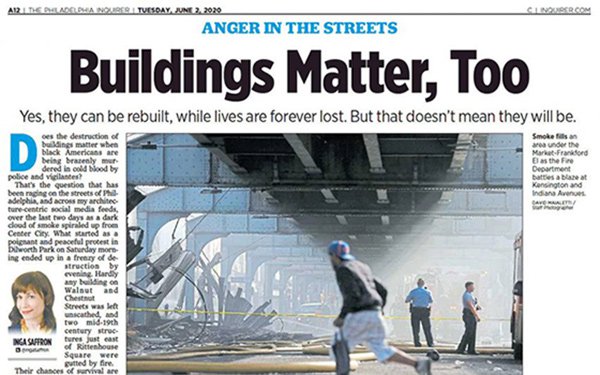
The Philadelphia
Inquirer has made changed its coverage of race, after a year-long review of its practices.
The analysis was prompted by a headline published last June 2: “Buildings
Matter, Too.”
“If printing those words in 72-point type had occurred in a vacuum, it would have been a grievous and unpardonable offense,” writes Elizabeth H.
Hughes, publisher-CEO of the Philadelphia Inquirer.
“That it was published at a moment of national reckoning over social justice — prompted by the vicious
murder of George Floyd at the hands of the police a year ago yesterday — amplified the outrage and brought us well-deserved scorn and scrutiny,” Hughes continues.
Like
many big-city dailies, the Inquirer has overemphasized crime and been racially insensitive in its coverage, Hughes said.
advertisement
advertisement
Roughly 80 team members, more than one-third of
the newsroom staff, met weekly in working groups in an effort to make the Inquirer “an anti-racist news organization,” Hughes adds. All of their suggestions were adopted.
Specifically, the Inquirer has:
- Produced an anti-racism workflow guide that provides specific questions reporters and editors should ask themselves at various stages of the journalistic process.
- Established
a Community News Desk to address shortcomings in how the paper portrays Philadelphia communities, “which have often been stigmatized by coverage that over-emphasizes crime,” Hughes
writes.
- Created an internal forum for journalists to seek guidance on potentially sensitive content and to make anti-racism central to their journalism.
- Commissioned an
independent audit that resulted in a critical
assessment of the paper’s journalism. Many recommendations are being addressed, and a process for tracking progress is being developed.
- Trained staff and managers on how
to spot and avoid cultural bias.
- Examined the Inquirer’s crime and criminal justice coverage with Free Press, a nonprofit focused on racial justice in media.
- Set diversity goals for 2021 regarding promotions, hiring, and representation in leadership.
- Established a formal process that will allow certain types of stories to be rendered
harder to find in online searches.
Hughes concedes: “There is something of a playbook whenever a self-inflicted crisis like this threatens to define any institution
and the people who work for it,” Hughes writes of the offending June 2 headline. “And so it played out here. Apologies were issued, a change in newsroom leadership was announced, earnest
promises of reform and redress were made.”
Other newsrooms are doubtless conducting analyses of this sort, to one degree or another. They do so in a heavily politicized time, when
newspapers are fighting for their survival.
“A lot remains to be done — and there are likely challenges ahead that we can’t anticipate,” Hughes says.
“But if reckoning requires a commitment to change and a clear path to reach it, then I hope you agree that our progress in the last year is tangible proof of both.”